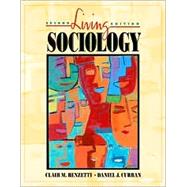
All chapters conclude with “Key People and Concepts” and “Learning More.”
I. THE DISCIPLINE OF SOCIOLOGY.
1. Sociological Perspectives.
What Is Sociology?
The Origins and Development of Sociology.
Contemporary Sociological Perspectives.
Becoming a Sociologist.
Connections.
Summing Up Chapter 1.
2. Sociological Inquiry.
The Science of Sociology.
The Research Process.
Methods of Sociological Research.
Linking Theory and Research: The Inductive and Deductive Models.
Objectivity in Sociological Research.
Ethics and Politics in Sociological Research.
Connections.
Summing Up Chapter 2.
3. Societies.
Social Structure.
Types of Societies.
Future Prospects.
Connections.
Summing Up Chapter 3.
II. SOCIETY.
4. Culture.
The Interaction of Biology and Culture.
The Elements of Culture.
Cultural Diversity: What's the Difference?
Theoretical Perspectives on Culture.
Culture and Human Nature.
Connections.
Summing Up Chapter 4.
5. Socialization.
The Interaction of Biology and Environment.
Explaining Our Humanity.
Agents of Socialization.
Socialization as Lifelong Learning.
Connections.
Summing Up Chapter 5.
6. Social Interaction in Groups and Organizations.
Social Groups.
Behavior in Groups.
Formal Organizations.
Connections.
Summing Up Chapter 6.
7. Deviance and Social Control.
Explaining Deviance.
Nonsociological Theories of Deviance.
Sociological Theories of Deviance.
Crimes and Criminals.
Social Control.
The Criminal Justice System.
Connections.
Summing Up Chapter 7.
III. STRUCTURES OF INEQUALITY.
8. Stratification and Social Class in the United States.
Systems of Stratification.
Explaining Stratification.
Social Classes in the United States.
Social Mobility.
Economic Inequality in the United States.
Poverty in the United States.
Connections.
Summing Up Chapter 8.
9. Global Stratification.
Global Stratification: An Overview.
Poverty in Global Perspective.
Explaining Global Inequality.
What Does the Future Hold?
Connections.
Summing Up Chapter 9.
10. Sex, Gender, and Sexual Orientation.
Theoretical Perspectives on Gender.
Sex and Gender: The Interaction of Nature and Environment.
Sexual Orientation.
Gender and Sexual Orientation as Systems of Stratification.
Gender and Sexual Orientation in the Workplace.
Gendered Violence.
Gender, Sexual Orientation, and Social Change.
Connections.
Summing Up Chapter 10.
11. Race and Ethnicity.
Racial, Ethnic, and Minority Groups.
Prejudice and Discrimination.
Assimilation and Pluralism.
Race and Ethnicity in the United States.
Explaining Racial and Ethnic Stratification.
Connections.
Summing Up Chapter 11.
12. Aging and the Life Course.
Aging around the World.
Aging: Myths and Realities.
Theoretical Perspectives on Aging.
Diversity in Aging.
Connections.
Summing Up Chapter 12.
IV. SOCIAL INSTITUTIONS.
13. The Economy and Work.
Economies in Historical Perspective.
Types of Economic Systems.
The U.S. Economy.
Work in the United States.
Connections.
Summing Up Chapter 13.
14. Politics and Government.
Power, Authority, and the State.
Types of Government.
Politics and Government in the United States.
Sociological Theories of the Political Process.
Warfare and the Military.
Connections.
Summing Up Chapter 14.
15. Families and Intimate Relationships.
Families throughout the World: Structures and Characteristics.
Sociological Perspectives on Families.
Families and Intimate Relationships in the United States.
Violence in Families.
Racial and Ethnic Diversity in U.S. Families.
Connections.
Summing Up Chapter 15.
16. Education.
Schools and Societies.
Sociological Theories of Education.
Problems in Education.
Educational Challenges in the Twenty-First Century.
Connections.
Summing Up Chapter 16.
17. Religion.
The Sociology of Religion.
Sociological Theories of Religion.
Types of Religious Organizations.
World Religions.
Religion in the United States.
Religion, Technology, and Social Change.
Connections.
Summing Up Chapter 17.
18. Health and Medicine.
Defining Health and Medicine.
Sociological Perspectives on Health and Medicine.
Health and Medicine across Societies.
Health in the United States.
Medicine in the United States.
Health Care Challenges for the Twenty-First Century.
Connections.
Summing Up Chapter 18.
V. SOCIAL CHANGE.
19. Population, Urbanization, and the Environment.
Population: Growth and Control
The Urban Environment.
The Natural Environment.
Connections.
Summing Up Chapter 19.
20. Social Change, Collective Behavior, and Social Movements.
Theories of Social Change.
Sources of Social Change.
Collective Behavior.
Explaining Collective Behavior.
Social Movements.
Social Movements, Social Change, and Our Future.
Connections.
Summing Up Chapter 20.
References.
Glossary.
Name Index.
Subject Index.
Credits.
The New copy of this book will include any supplemental materials advertised. Please check the title of the book to determine if it should include any access cards, study guides, lab manuals, CDs, etc.
The Used, Rental and eBook copies of this book are not guaranteed to include any supplemental materials. Typically, only the book itself is included. This is true even if the title states it includes any access cards, study guides, lab manuals, CDs, etc.